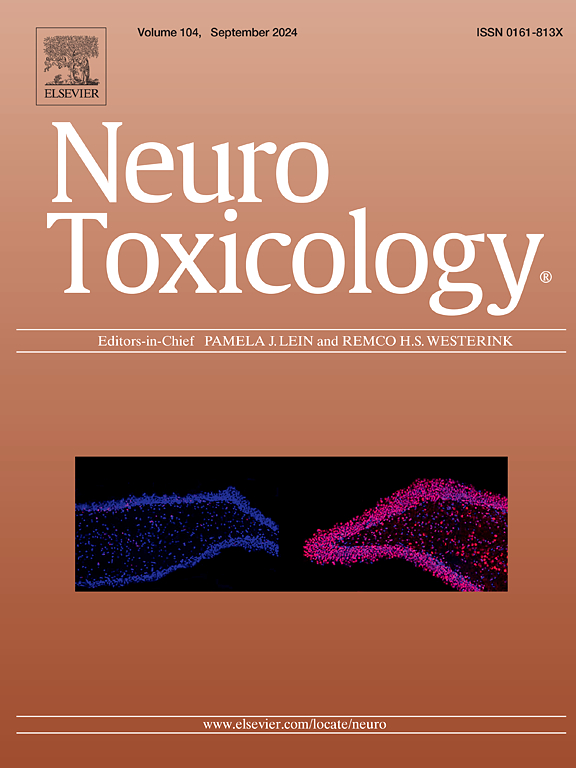EphA/EphrinA5信号通路参与苯并[a]芘引起的突触异常重构和神经毒性。
IF 3.9
3区 医学
Q2 NEUROSCIENCES
引用次数: 0
摘要
苯并[a]芘(B[a]P)被认为是一种高度神经毒性污染物,然而,其潜在机制仍知之甚少。本研究旨在体外和体内研究B[a] p诱导的神经毒性背景下产生促红细胞生成素的肝细胞受体(EphA4、EphA5)及其配体(Ephrin A5)的变化。共有40只雄性小鼠被腹腔注射溶剂(花生油)或B[A]P溶液(剂量为0.5、2和10mg/kg),为期60天,每隔一天注射一次。在30次暴露后,对小鼠进行探索性行为评估,透射电镜观察海马超微结构改变,western blotting检测突触相关蛋白(SYP, PSD95)以及大脑皮层EphA4, EphA5和Ephrin A5蛋白。采用HT22海马神经元细胞进行平行实验。结果表明,B[a]P治疗导致大鼠空间认知功能和自发性行为受损,突触重构异常,SYP和PSD95蛋白水平降低。值得注意的是,与对照组相比,B[a]P中、高剂量处理后小鼠大脑皮层EphA4、EphA5蛋白水平明显升高,而Ephrin A5蛋白水平在高剂量下明显降低。此外,B[a]P(0、0.2、2和20μM)处理HT22细胞48小时后,细胞活力和细胞数量均明显下降,并伴有异常的神经元突触重构。与对照细胞相比,B[a]P处理后,HT22细胞中EphA4和EphA5蛋白水平显著升高,而Ephrin A5蛋白水平明显降低。这些发现表明,B[a]P可能通过EphA/EphrinA5信号通路破坏突触重塑,从而诱导神经毒性。本文章由计算机程序翻译,如有差异,请以英文原文为准。
EphA/EphrinA5 signaling pathway involved in the abnormal synaptic remodeling and neurotoxicity caused by benzo[a]pyrene
Benzo[a]pyrene (B[a]P) is recognized as a highly neurotoxic contaminant, however, the underlying mechanisms remain poorly understood. This study aimed to examine the alterations in erythropoietin-producing hepatocyte receptors (EphA4, EphA5) and their ligands (Ephrin A5) in the context of B[a]P-induced neurotoxicity, both in vivo and in vitro. A total of forty male mice were administered intraperitoneal injections of either a solvent (peanut oil) or a B[a]P solution (at doses of 0.5, 2, and 10 mg/kg) over a period of 60 days, once every other day. Following 30 exposures, the mice were subjected to exploratory behavioral assessments, transmission electron microscopy for hippocampal ultrastructural alterations, and western blotting to measure synapse-associated proteins (SYP, PSD95), as well as EphA4, EphA5, and Ephrin A5 proteins in the cerebral cortex. Parallel experiments were conducted using HT22 hippocampal neuronal cells. The results indicated that B[a]P treatment led to impairments in spatial cognitive function and spontaneous behavior, abnormal synaptic remodeling, and reduced SYP and PSD95 protein levels. Notably, compared to the control group, there was a marked increase in the protein levels of EphA4 and EphA5 in the cerebral cortex of mice following B[a]P treatment at mid and high doses, while Ephrin A5 protein level was significantly depressed at high dose. Additionally, in HT22 cells treated with B[a]P (0, 0.2, 2, and 20 μM) for 48 h, both cell viability and cell numbers exhibited a significant decline, accompanied by abnormal neuronal synaptic remodeling. In comparison to the control cells, EphA4 and EphA5 protein levels were significantly elevated in HT22 cells following B[a]P treatment, whereas Ephrin A5 protein levels were notably suppressed. These findings suggest that B[a]P may induce neurotoxicity through the disruption of synaptic remodeling via the EphA/EphrinA5 signaling pathway.
求助全文
通过发布文献求助,成功后即可免费获取论文全文。
去求助
来源期刊

Neurotoxicology
医学-毒理学
CiteScore
6.80
自引率
5.90%
发文量
161
审稿时长
70 days
期刊介绍:
NeuroToxicology specializes in publishing the best peer-reviewed original research papers dealing with the effects of toxic substances on the nervous system of humans and experimental animals of all ages. The Journal emphasizes papers dealing with the neurotoxic effects of environmentally significant chemical hazards, manufactured drugs and naturally occurring compounds.
 求助内容:
求助内容: 应助结果提醒方式:
应助结果提醒方式:


